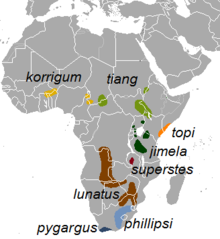| Damaliscus | |
|---|---|

| |
| A female topi (Damaliscus lunatus jimela) | |
| Scientific classification | |
| Domain: | Eukaryota |
| Kingdom: | Animalia |
| Phylum: | Chordata |
| Class: | Mammalia |
| Order: | Artiodactyla |
| Family: | Bovidae |
| Subfamily: | Alcelaphinae |
| Genus: | Damaliscus P.L. Sclater & Thomas, 1894 |
| Type species | |
| Antilope pygargus Pallas, 1767
| |
| Species | |

| |
| Subspecies range map of the genus Damaliscus | |
The genus Damaliscus, commonly known as damalisks, is a genus of antelope in the family Bovidae, subfamily Alcelaphinae, found in Africa.
Species
[edit]| Common name | Scientific name and subspecies | Range | Size and ecology | IUCN status and estimated population |
|---|---|---|---|---|
| topi, tiang or tsessebe[3] | Damaliscus lunatus Burchell, 1824[4] Six subspecies
|
Angola, Zambia, Namibia, Botswana, Zimbabwe, Eswatini, and South Africa
|
Size: Habitat: Diet: |
LC
|
| bontebok | Damaliscus pygargus (Pallas, 1767) |
South Africa, Lesotho and Namibia | Size: Habitat: Diet: |
VU
|
|
|
† Damaliscus hypsodon (Faith et al., 2012) |
Known from the Middle-Late Pleistocene of East Africa; became extinct at the onset of the Holocene due to the loss of its grassland habitat[5] | Size: Habitat: Diet: |
EX
|
|
|
† Damaliscus niro Hopwood, 1936 |
Known from throughout the Pleistocene of eastern and southern Africa; became extinct around 63,000 years ago.[5] | Size: Habitat: Diet: |
EX
|
References
[edit]Wikimedia Commons has media related to Damaliscus.
Wikispecies has information related to Damaliscus.
- ^ Wilson, D. E.; Reeder, D. M., eds. (2005). Mammal Species of the World: A Taxonomic and Geographic Reference (3rd ed.). Johns Hopkins University Press. ISBN 978-0-8018-8221-0. OCLC 62265494.
- ^ "Genus Damaliscus". IUCN Red List of Threatened Species. Retrieved 2018-10-28.
- ^ Kingdon, J (2015-04-23). The Kingdon Field Guide to African Mammals. San Diego, CA: Academic Press. pp. 428–431. ISBN 9781472921352.
- ^ a b c d East, Rod (1998). "African Antelope Database". IUCN Species Survival Commission. 21: 200–207.
- ^ a b Faith, J. Tyler; Potts, Richard; Plummer, Thomas W.; Bishop, Laura C.; Marean, Curtis W.; Tryon, Christian A. (November 2012). "New perspectives on middle Pleistocene change in the large mammal faunas of East Africa: Damaliscus hypsodon sp. nov. (Mammalia, Artiodactyla) from Lainyamok, Kenya". Palaeogeography, Palaeoclimatology, Palaeoecology. 361–362: 84–93. Bibcode:2012PPP...361...84F. doi:10.1016/j.palaeo.2012.08.005.
- Stuart, Chris & Stuart, Tilde (2007). Field Guide to Mammals of Southern Africa. Fourth edition. Cape Town:Struik Publ.

